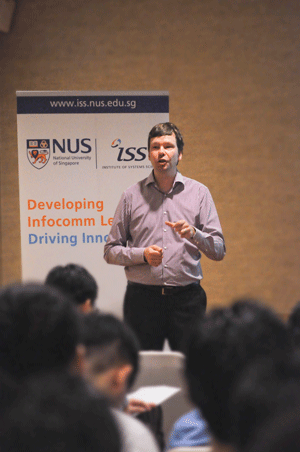In December, global software consultancy ThoughtWorks gave over 80 IT professionals a heads-up on the latest developments on its technology radar at a seminar it co-hosted with ISS.
Twice a year, ThoughtWorks publishes a technology radar paper that captures the output of a group of 20 senior technology leaders in the organisation who meet regularly to discuss the technology trends that significantly impact the IT industry. In this Singapore briefing, Erik Dörnenburg, Global Head of Technology at ThoughtWorks, shared the company’s latest technology radar paper issued in October.

Trend #1: Reproducible environments
The future is heading towards the standardisation, set-up automation and coordinated management of development, test and production environments. Said Erik, “We are saying that all your infrastructure should be treated as code.”
Trend #2: Simple architecture
“The trend is for architectures that are simple and adequate for the problems they are solving.” said Erik. This movement includes an uptick in the adoption of micro-services as a technique for distributed system design and the use of practical and elegant solutions such as Edge Side Includes (ESI) for page composition. Micro-frameworks are also emerging as a way to handle increasing complexity in applications both on client and server side. Avoid the use of Java Portal servers, advised Erik; they are not worth the effort. “The problem is the ivory tower syndrome, commented Erik. “We have architects who have no idea of the consequence of the standards they write.”
Trend #3: Accessible analytics
Big data does not neccessarily require equally big budgets. Do not buy business intelligence products; bake it into your solutions, counselled Erik. Build software that answers questions that your organisation really has, he added. Advanced analytics techniques such as machine learning, semantic analysis, text mining and quantitative analytics have matured over the past 15 years and they now offer incredible potential for prediction, forecasting and identifying repeatable patterns, and providing insight into unstructured data. Among the tools highly recommended by Erik are Highcharts, a JavaScript-based client-side graphing and visualisation solution with out-of-the-box support for multiple highly-configurable interactive chart types, and the ability to easily render large data sets, and D3, a JavaScript library for binding datasets into the DOM, and then transforming the document to create rich visualisations ranging from graphs to heat maps. A platform recommended by Erik is Neo4j, which stores information as arbitrarily interconnected nodes linked by named relations, rather than as tables and joins. Schema-less and highly extensible, it is an excellent choice for modelling semi-structured data in complex domains.
Trend #4: Emphasis on mobile.
This clear trend takes in ‘mobile first’ design as well as a new breed of testing tools. Stressed Erik, “Most B2C firms will get the majority of their traffic from mobile devices so why not design for the dominant device – mobile - and then add on features for web browsers?” This trend includes the use of responsive web designs that automatically shuffle according to the size of the end user’s mobile screen.
Stuart Smith, Chief of Digital Innovation & Design Practice at the Institute of Systems Science, also spoke at the event. He covered the skills and qualities that organisations and IT professionals need to remain viable in this knowledge-driven age. Read more here.
If you would like to attend events like this in future, please write in to ISSnews@nus.edu.sg.
Click here to subscribe to ISS mailing list.